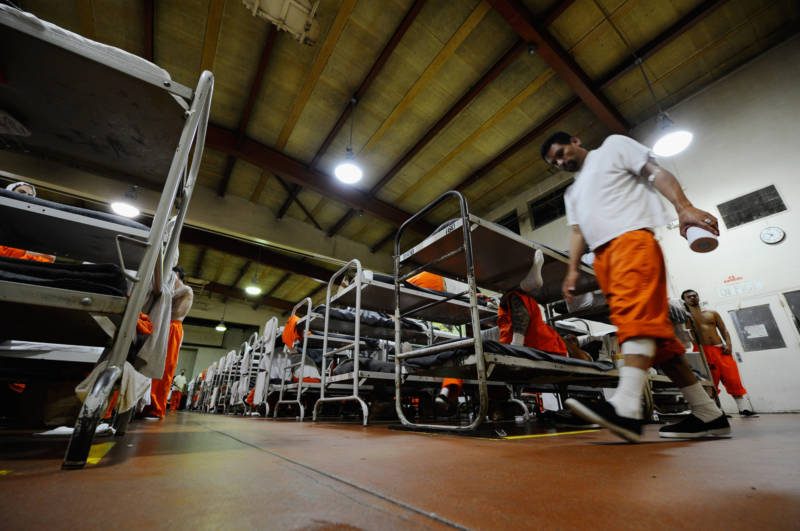While law enforcement groups came on board, many remained wary of realignment -- and Republican lawmakers and other law-and-order politicians warned that the massive policy change could lead to "blood in the streets."
Half a decade later, most public officials say -- and research shows -- that those fears have not come to pass.
The most comprehensive study of realignment's impacts was released this spring, spearheaded by researchers at the Public Policy Institute of California. UC Irvine criminologist Charis Kubrin worked on what she calls the first "systematic, scientific analysis" of realignment.
"I would say it's been a success ... realignment didn't unleash a crime wave, and not only that, it had no impact on violent crimes and very little impact on property crimes," she said. "That tells me we can downsize our prisons, at least in California, without harming public safety. It's an important message for other states to listen to. Letting counties manage offenders locally, I think, is a great way to address the ballooning prison population without harming public safety."
But PPIC researchers said in a paper released this week that the change has not resulted in less spending on corrections overall -- it's just shifted down to the county level -- and that jails are now facing crowding problems.
Under realignment, each county was given funds from the state and had the flexibility to implement realignment the way it wanted to. Probation departments took the lead, because they are responsible for overseeing offenders when they are released -- and all of them affected by realignment would be released. Kubrin said her research shows that the counties with the most success -- including the lowest recidivism rates and highest re-entry success rates -- were the counties that embraced a model of rehabilitation instead of simply relying on incarceration.
Amador County Probation Chief Mark Bonini has led his department for nine years, and heads the statewide association that represents probation chiefs. He said there's still work to be done, but "if the needle leans one way or another, I would say it leans toward success."
Probation departments, he said, have far more resources at their disposal now to do the important work of helping offenders get jobs, stay sober and improve their lives.
"I think we are more safe in that we are providing programming to a piece of the population ... that weren't getting those services before," he said, noting that the offenders impacted by realignment were coming back to communities before -- just with less support. "We knew them already, we knew their families. ... I feel like we are doing better now than the state was."
He said the flexibility offered by the state in implementing such a complicated policy shift was key.
"One of the things that was, I think, a cornerstone of realignment and a real positive was that counties could set things up the way they wanted to," Bonini said.
Not everyone is such a fan. Ventura County District Attorney Greg Totten said he thinks realignment, when combined with another major policy change enacted by voters, has led to increased crime rates. He said the PPIC study looked at only a few years of crime rates and that in 2015, violent and property crimes increased significantly.
He blames not just realignment, but Proposition 47, which made drug possessions and many property crimes misdemeanors instead of felonies. It resulted in further drops in the prison population, and some emptying of county jail beds as well.
"There's no question in my mind that the 10 percent increase in violent crimes we have experienced, the increased property crimes, rapes, robberies, murders -- that there's a nexus between that and realignment and Prop. 47," he said. "I know the governor was under tremendous pressure, that he felt compelled to come up with something to relieve prison overcrowding, and he has accomplished that."
But Totten believes that compliance came at the expense of public safety.
Lenore Anderson helped write and push Proposition 47 as head of a group called Californians for Safety and Justice. She disagrees with Totten's assessment of what realignment and Proposition 47 have done -- but agrees it's hard to disentangle their impacts.
"Fearmongering is how we got to a bloated and costly prison system in the first place," she said. "So much of the so-called tough-on-crime era was shepherded in by a lot of hysteria and myth -- hysteria about crime and myth about the best way to stop it. So it came as no surprise to me that realignment faced pushback, and pushback that sounded pretty familiar."
Anderson said realignment was the start of a trend toward a more "balanced" approach to criminal justice that she believes will ultimately make California safer by helping people deal with the root causes of crime, not just punishing them for their actions.
Cate is now head of the California State Association of Counties, representing county governments in the Capitol. He said Brown's big gamble resulted in a big success.
"It took a lot of guts," he said. "And it paid off for him eventually."
